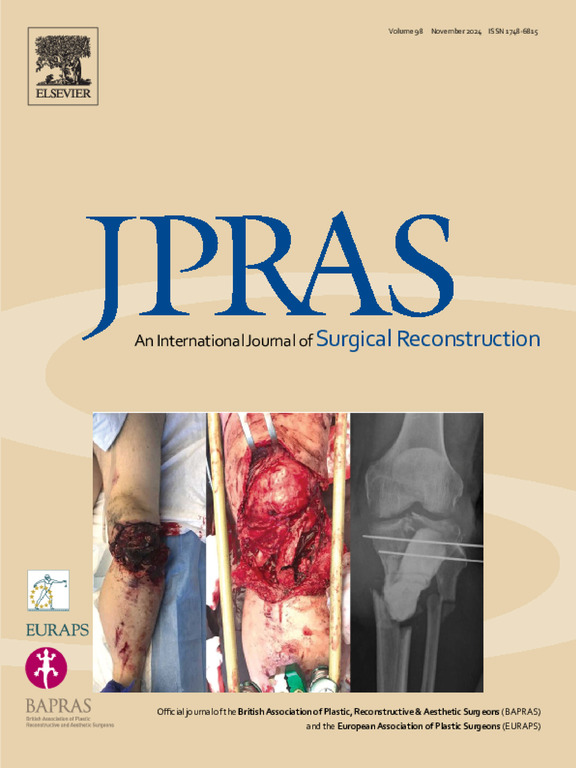机器学习有助于神经源性胸廓出口综合征和腕管综合征的鉴别诊断。
IF 2.4
3区 医学
Q2 SURGERY
Journal of Plastic Reconstructive and Aesthetic Surgery
Pub Date : 2025-09-05
DOI:10.1016/j.bjps.2025.09.004
引用次数: 0
摘要
神经源性胸廓出口综合征(nTOS)和腕管综合征(CTS)相关症状可能重叠,导致诊断不确定性。在本研究中,我们使用机器学习模型通过与CTS的比较来识别nTOS的关键预测因子。方法:我们回顾了因nTOS (n = 68)或CTS (n = 65)接受手术干预的患者记录。使用Python中的scikit-learn库开发机器学习模型,并开发了包含患者病史和体检结果的二元逻辑回归模型,以区分nTOS和CTS。采用agresti - coult置信区间、卡方拟合优度和二项检验比较Tinel符号和划痕塌陷试验(SCT)的阳性率。结果:基线随机森林模型诊断nTOS准确率达到80.0% (f1得分为0.76,受试者工作特征曲线下面积为0.91)。经过超参数调优后,精度提高到85.0%,精度达到1.0,整体性能提高7.7%。单独的Tinel征象和SCT均可诊断nTOS和CTS,但不能区分两种情况。在基线和优化随机森林模型中,Roos/高臂压力测试、体重指数和手术前症状持续时间是nTOS最具影响力的预测因素。结论:随机森林模型预测nTOS的准确率高达85%。SCT和Tinel的单独测试无法区分nTOS和CTS。在机器学习模型中结合多个临床和人口统计学变量,在区分nTOS和CTS方面获得了更高的诊断准确性。本文章由计算机程序翻译,如有差异,请以英文原文为准。
Machine learning can aid in the differential diagnosis of neurogenic thoracic outlet syndrome and carpal tunnel syndrome
Introduction
Symptoms related to neurogenic thoracic outlet syndrome (nTOS) and carpal tunnel syndrome (CTS) may overlap, leading to diagnostic uncertainty. In this study, we used a machine learning model to identify key predictors of nTOS by comparing it with CTS.
Methods
We reviewed records of patients who underwent surgical intervention for nTOS (n = 68) or CTS (n = 65). The machine learning model was developed using the scikit-learn library in Python, and a binary logistic regression model incorporating patient history and physical exam findings was developed to differentiate nTOS from CTS. Positivity rates of Tinel’s sign and the scratch collapse test (SCT) were compared using Agresti-Coull confidence intervals, chi-squared goodness-of-fit, and binomial tests.
Results
For diagnosis of nTOS, the baseline random forest model achieved 80.0% accuracy (F1-score: 0.76, area under the receiver operating characteristic curve: 0.91). After hyperparameter tuning, accuracy improved to 85.0% and precision reached 1.0, yielding a 7.7% gain in overall performance. Both Tinel’s sign and SCT in isolation were diagnostic of nTOS and CTS but could not differentiate between the 2 conditions. In both the baseline and optimized random forest model, the Roos/Elevated Arm Stress Test, body mass index, and duration of symptoms prior to surgery emerged as the most influential predictors of nTOS.
Conclusions
The random forest model predicted nTOS with up to 85% accuracy. SCT and Tinel’s tests in isolation could not distinguish between nTOS and CTS. Combining multiple clinical and demographic variables within a machine learning model yielded superior diagnostic accuracy for distinguishing nTOS from CTS.
求助全文
通过发布文献求助,成功后即可免费获取论文全文。
去求助
来源期刊
CiteScore
3.10
自引率
11.10%
发文量
578
审稿时长
3.5 months
期刊介绍:
JPRAS An International Journal of Surgical Reconstruction is one of the world''s leading international journals, covering all the reconstructive and aesthetic aspects of plastic surgery.
The journal presents the latest surgical procedures with audit and outcome studies of new and established techniques in plastic surgery including: cleft lip and palate and other heads and neck surgery, hand surgery, lower limb trauma, burns, skin cancer, breast surgery and aesthetic surgery.

 求助内容:
求助内容: 应助结果提醒方式:
应助结果提醒方式:


